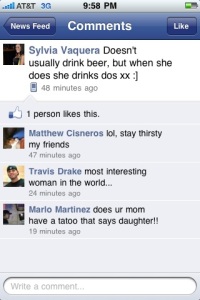You are currently browsing the category archive for the ‘Video’ category.
This commercial is obviously geared towards men. It uses the objectification of women as a marketing tool to entice male audiences into using their product. It is definitely too inappropriate for TV audiences in the United States but I found that it perfectly exemplified our hypothesis. Alcohol advertisements are very meticulously designed to be geared towards specific gender audiences. This video is advertising Guinness beer, and is congruent with a pretty standard advertising trend in most beer ads, geared towards sex and geared towards men. This commercial in particular is aimed at a younger, more immature audiences. The men in the ad treat the beer in a congruent fashion as they do the woman, as an object that is to be shared. The concept of objectifying this woman and relating “share one with a friend” to both the beer bottle and the female is an inappropriate ideology that is unfortunately widely shared in many cultures. Again, this specific commercial is an extreme of the techniques used to market beer to en, but does an excellent job of exemplifying the concept of using sex to sell alcohol.
-JA
After viewing a vast array of alcohols in advertising, I noticed one missing from the crowd: wine. Which caused me to look back and realize that, throughout my life, I cannot recall one specific wine advertisement. Yet wine takes up several aisles in supermarkets and proves popular with the public. With such a strong following, why do wines not take advantage of advertising?
Though wine is not advertised directly in advertisements, I saw its appearance throughout magazines and television. What I observed is that wine is usually associated with romance, appearing as the beverage when couples drink together.

Couples drinking wine together at dinner. Article in Cosmopolitan April 2010.

Wine Cooler advertised for "Bridal Registry" in Cosmopolitan April 2010. This affirms wine being popular with couples (wedding gift) and with females specifically (featured in a women's magazine).
Wine seems to be more accepted among the female population. However, in media, it is also featured with high-brow males. A prime example is in the popular show Frasier.

Article in Esquire April 2010 pictures Tina Fey with a bottle of wine, showing how it is a popular drink with females.
Frasier, his brother Niles, and men are part of “The Corkmasters”, a wine club. Additionally, Frasier plans to host a radio show about wine to fellow enthusiasts. Shown in the first 3:30 minutes.
However, after a long search, I was able to find a wine advertisement:

Kendall-Jackson Chardonnay ad: Esquire April 2010
Surprisingly, the ad was featured in Esquire, a men’s magazine. However, like Frasier, the ad seems to target a more high-brow male audience. The ad features a lot of text and information, categorizing it as one of “The Rationalistic Image” which “is reflected both by practitioners of reason-why advertising and by rationalistic academic psychology…” (Leiss,Kline, Jhally, Botterill 151-55). Hence, the consumer is more knowledgeable and, therefore, more sophisticated.
Hence, wine proves to be popular among both genders and often brings them together, especially in romantic situations. However, when the gender markets are separated, a divide surfaces. Wine is more accepted among females, where a woman can drink wine at any occasion and even by herself (as seen in the image with Tina Fey). Males that enjoy wine, though, must be of a higher social-status and better-educated. This could have a positive connotation, where these refined men are respected. However, negativity may also occur; well-mannered men tend to be well-groomed and, therefore, effeminate. Furthermore, this may be enhanced by their drinking of wine, a popular women’s drink.
-SG
Dos Equis and their campaign of “the most interesting man in the world”
Dos Equis is not only selling their product of beer, but they are also selling a lifestyle.
According to market research by Millward Brown, the TV ad is in the top five percent of most enjoyable ads in U.S. research history, posturing the Most Interesting Man to become pop culture’s next brand-recognized advertising icon. The ad is targeted at a specific audience, adult men who live wild, interesting lives.
The campaign has become popular on many levels, mainly class and sophistication. It makes viewers believe that if they drink Dos Equis, they too will be interesting.
I even spotted within my own group of friends a reference to the ad.
As seen in the comments that follow, others recognize the reference of the ad and respond.
KC

